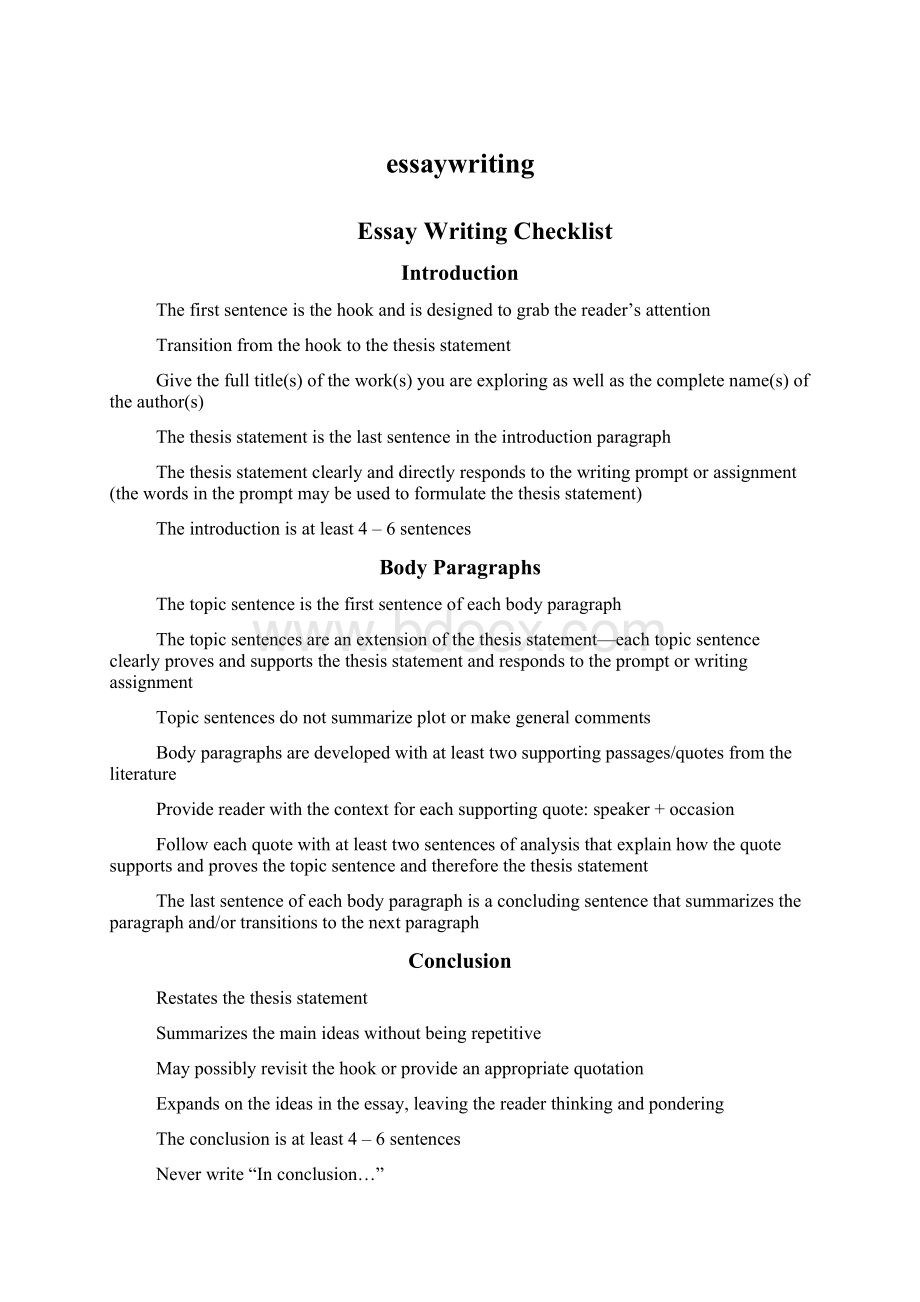essaywriting.docx
《essaywriting.docx》由会员分享,可在线阅读,更多相关《essaywriting.docx(10页珍藏版)》请在冰豆网上搜索。

essaywriting
EssayWritingChecklist
Introduction
Thefirstsentenceisthehookandisdesignedtograbthereader’sattention
Transitionfromthehooktothethesisstatement
Givethefulltitle(s)ofthework(s)youareexploringaswellasthecompletename(s)oftheauthor(s)
Thethesisstatementisthelastsentenceintheintroductionparagraph
Thethesisstatementclearlyanddirectlyrespondstothewritingpromptorassignment(thewordsinthepromptmaybeusedtoformulatethethesisstatement)
Theintroductionisatleast4–6sentences
BodyParagraphs
Thetopicsentenceisthefirstsentenceofeachbodyparagraph
Thetopicsentencesareanextensionofthethesisstatement—eachtopicsentenceclearlyprovesandsupportsthethesisstatementandrespondstothepromptorwritingassignment
Topicsentencesdonotsummarizeplotormakegeneralcomments
Bodyparagraphsaredevelopedwithatleasttwosupportingpassages/quotesfromtheliterature
Providereaderwiththecontextforeachsupportingquote:
speaker+occasion
Followeachquotewithatleasttwosentencesofanalysisthatexplainhowthequotesupportsandprovesthetopicsentenceandthereforethethesisstatement
Thelastsentenceofeachbodyparagraphisaconcludingsentencethatsummarizestheparagraphand/ortransitionstothenextparagraph
Conclusion
Restatesthethesisstatement
Summarizesthemainideaswithoutbeingrepetitive
Maypossiblyrevisitthehookorprovideanappropriatequotation
Expandsontheideasintheessay,leavingthereaderthinkingandpondering
Theconclusionisatleast4–6sentences
Neverwrite“Inconclusion…”
OtherImportantAspects
Useformalwritingstyle,tone,andlanguage
Avoidslang,poordiction,non-specificlanguage,andcontractions
Avoidaddressingthereaderandtheuseoffirst-person
Avoidaskingrhetoricalquestions
BemindfulandawareofMLAformatincitingyoursourcesinthetext
Payattentiontospelling,punctuationandgrammar
Alwaysproofreadandself-edityourwork
Giveyouressayacreative,thoughtfulandinterestingtitle
Takeprideinyourworkandgivetheessay100%ofyoureffort!
TopicSentenceChecklist
Aneffectivetopicsentence:
Provesandsupportsathesisstatement
Tellsthereaderthefocusoftheparagraph
Statesaclaim,idea,orassertion—theauthor’sexpertopinionabouttheliterature
Likethethesisstatement,addresseshow/whyquestions
Isveryclearandveryspecific
Avoids1stpersonpointofview
Avoidsplotsummary
Avoidsstatingtheobvious
Avoidsabstractideasandlanguage
Avoidspassivevoice
UsingSupportingDetailsChecklist
Considerthefollowingwhenusingsupportingquotesandpassagesinyourwriting:
Leadintoorsetupyourquote/passagewithspeaker(character/narrator)andoccasion(context,orwhat’shappeningintheplot
Followupaquotewithatleasttwosentencesofcommentaryandanalysisbeforemovingontothenextsupportingdetail
Avoidexcessiveplotsummary
Besurethequoteisrelevanttoyourtopicsentenceandthesis—doesyourquotehelpproveyourpoint
Avoidlettingthequotespeakforitself—avoid“dropping”thequote
ActiveandAcademicVerbstoUseinCriticalLiteraryAnalysis
Emphasizes
Elucidates
Compares
Suggests
Creates
Illustrates
Exemplifies
Parallels
Juxtaposes
Implies
Alludesto
Observes
Identifies
Organizes
Reinforces
Defines
Clarifies
Contrasts
Argues
Mirrors
Echoes
Develops
Connotes
Focuses
Balances
Relates
Expresses
Insinuates
Demonstrates
AnatomyofaParagraph&ParagraphChecklist
Considerthefollowingmodelofatypicalliteraryanalysisparagraph:
TopicSentence*
Supporting
Detail*
Supporting
Detail*
Supporting
Detail*
ConcludingSentence
Eachsupportingdetailismadeupof:
1.Lead-inorset-up:
Speaker+Occasion
2.Directquoteorpassage
3.Atleasttwosentencesoffollowingcommentary/analysis
TheConcludingSentence:
Wrapsupandsummarizestheparagraph
Transitionstothenextbodyparagraph
Avoidsthewords“inconclusion”or“insummary”
Considerthefollowingreminderswhencomposingaliteraryanalysisparagraph:
Usethestrongestargument,orsupportingdetail,last
Bemindfulofspelling,grammar,andpunctuation
Usepresenttenseverbswhenwritingliteraryanalysis
BemindfulofproperMLAformatwhencitingasource
Avoidpoordictionandslang
Avoidclichés,first-personpointofview,andaddressingthereader
ThesisStatements:
Strategies,Checklist,&Samples
Thethesisstatementinanessayofliteraryanalysisfunctionsasfollows:
-Itnarrowsyourtopictoacentralidea—alltopicsentencesandbodyparagraphswilldevelopandsupportthisidea
-Itassertssomethingspecificandsignificantaboutthetopic,conveyingyourexpertopinion
-Itmaypreviewhowyourideaswillbearrangedwithinyouressay
-Itislogical,precise,andreasonable
Herearesomestrategiesforformulatingathesisstatement:
I.Decodethewritingprompt:
Paycloseattentiontothelanguageoftheprompt.
Underlineorhighlightwordsthatindicatespecificareasoffocus.Usethelanguageof
thepromptwhilecomposingyourthesisstatement.
*Dependingonthepromptorassignmentyouaregiven,youmaybeableto
simplyrestatethepromptwhileincludingyouranswertohow/whyquestions.
II.TakeInventory:
Determinewhichsupportingdetailsorpassagescouldbeusedto
proveyourthesis.
*Becareful!
Avoidarbitrarilyselectingquotes.Becertainthesupportingdetails
youchoosedo,infact,supportthecentralidea.
III.IdentifyRelationships,Distinctions,&Categories:
Onceyouhaveavarietyof
supportingdetails,determinewhatvariousaspectsofthethesisstatementeach
detailsupports.Thesedistinctionsorcategorieswillbeusedtodeterminewhatyour
topicsentencesandbodyparagraphswillbemadeupof.
IV.ReviseandDraftAgain:
Rewritethethesisasmanytimesasnecessarytoachieve
satisfaction.Continuallyrefertotheprompttobesureyouaredirectlyand
specificallyrespondingtoitsrequirements.Youmayfindthatafteryouhavewritten
thebodyparagraphs,yourpaperhastakenadifferentdirection.Inthatcase,you
mustreviseyourthesisstatementtosuittherestoftheessay.
Considerthefollowingchecklistwhencomposingathesisstatement:
Donotusefirst-personpointofviewinathesisstatement,unlessyouarewritingapersonal
autobiographicalessay.Formalliteraryanalysisrequirestheuseofthirdpersonpointof
view.
Thethesisstatementshouldbelimitedtoonesentence.Inrarecases,twosentencesmay
benecessary.
Refertothewritingpromptfrequentlywhilecomposingthethesisandbesureyour
statementclearlyrespondstoallaspectsoftheprompt
Thethesisstatementislocatedattheendoftheintroductoryparagraphinatypical
literaryanalysisessay.
Thethesisisa“roadmap”fortheideaspresentedintheessay;itinformsthereaderwhat
willbeanalyzedintheessayandinwhatorder.
Thethesisstatementpresentsideasinlogical,clear,andspecificlanguage;itavoidsvagueor
abstractlanguage,poordiction,andslang.
Thethesisstatementisanalytical,notfactual;itconveystheauthor’sexpertopinion,or
assertionandavoidsstatingtheobvious.Itanswershowandwhyquestions.
Thethesisstatementislogical,precise,andreasonable.
TheIntroductionParagraph:
Strategies&Checklist:
Theintroductionparagraphinanessayofliteraryanalysisfunctionsasfollows:
-Itfocusesthereader’sattentiononthetopicandarousescuriosityaboutwhatyou
havetosay
-Itspecifiesyoursubjectandimpliesyourattitude/tone
-Itprovidesbackgroundnecessarytounderstandthethesisstatement
-Itisconciseandsincere
-Itcomestoapointwiththethesisstatement
AnatomyoftheIntroduction:
1stSentence:
HookorOpeningSentence
-Engagesthereader’sattention
2nd–3rdSentence
-Shouldmentiontheauthor’scompletename
andthecompletetitleoftheworkbeing
analyzed
3rd-5thSentences
-Functiontotransitionideasfromhooktothesis
ThesisStatement
-Finalsentence(s)oftheintroductionparagraph
StrategiesforComposingHooksorOpeningStatements:
-Useavividquotation
-Createavisualimagethatrepresentsyoursubject
-Createananalogyforyoursubject
-Offerasurprising/interestingstatisticorotherfact
-Stateanopinionrelatedtoyourthesis
-Askaquestionordefineawordcentraltoyoursubject(Note=Usethesetechniquesverysparinglyandcautiously,astheymaybeconsideredcliché)
Considerthefollowingchecklistwhenwritinganintroductionparagraph:
Theopeningsentenceorhookengagesthereader’sattention
Theintroductionavoids1stpersonpointofview,slang,andpoordiction
Specifictermsorlanguageareclearlydefined
Necessarybackgroundinformationisprovided
Theparagraphclearlyandlogicallytransitionsfromthehooktothethesisstatement
Thethesisstatementappearsattheendoftheintroduction
Theparagraphisclear,logical,andreasonable
Avoidvague/abstractlanguage
Avoidanattempttobecute,funny,orterriblyclever
Theintroductionisusually4–6sentences(longerintroductionstendtorambleanddetractfromthetopic)
Usespresenttenseverbsconsistently
TheConclusionParagraph:
Strategies,Checklist,&Samples
Theconclusionparagraphinaliteraryanalysisessayfunctionsasfollows:
-Itfinishesofftheessayandtellsreaderswherethewriterhasbroughtthem
-Itrestatesthethesisandcontainsechoesof